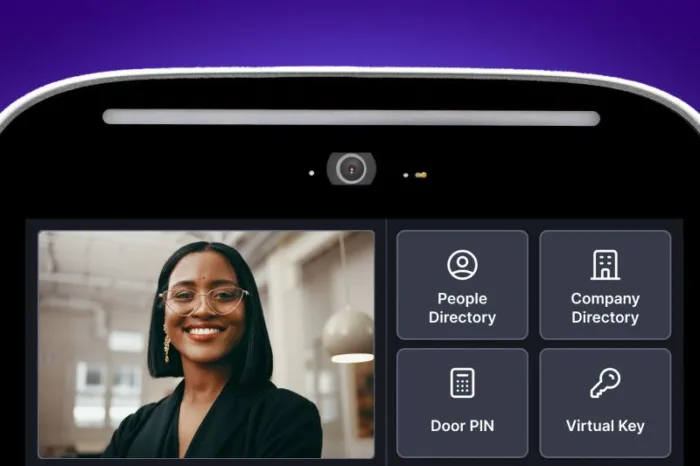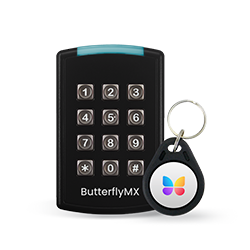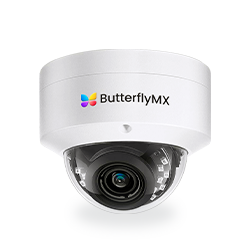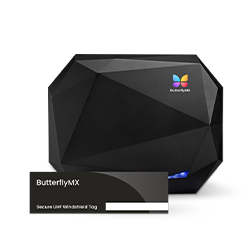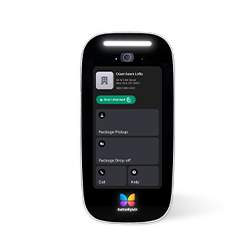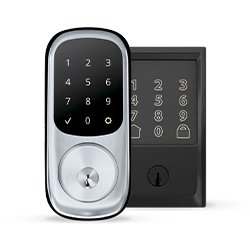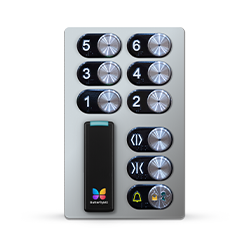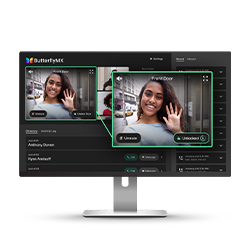Key takeaways:
- Installing a commercial intercom system at your property allows tenants to open the front door from a smartphone, and building staff can conveniently manage access from an online dashboard.
- A commercial intercom enables communication and property access in commercial, office, and industrial buildings.
- Benefits of an intercom include simplifying guest access, ensuring smooth package deliveries, keeping your building secure, and improving the tenant experience.
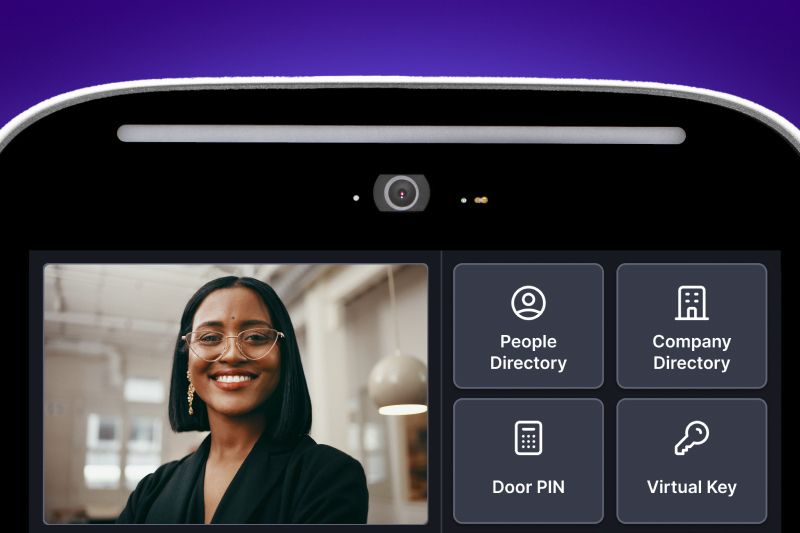
If you’re upgrading the building access system in your office or purchasing one for a new commercial development, you have a big decision to make: which commercial intercom system to install.
There are many options, some commercial intercoms are wireless, while others offer video. We’ve created this complete commercial intercom buyer’s guide to help you find the right intercom for your property. It will help you understand the important differences between commercial intercom systems and ensure you purchase the best video intercom for your building. Read on to learn about the features you should look for and the factors to consider when choosing a commercial intercom system.
Table of contents:
- What is a commercial intercom system?
- How does a commercial intercom system work?
- Types of commercial intercom systems
- Commercial intercom system use cases
- Benefits of a commercial intercom
- 11 commercial intercom system considerations
- Choosing a robust commercial intercom system
- Integrating your commercial intercom systems
- Commercial intercom system FAQs
More than 40K, 5-star reviews!
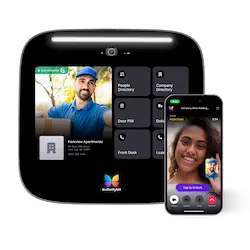
Video Intercoms
Open doors, gates & garages from anywhere.

QR Code Intercom
Smartphone-based visitor access.
Access Control
Fob, key cards, PINs, and mobile apps.
Security Cameras
Visibility throughout your property.
Vehicle Access
Hands-free access for gates & garages.
Package Room
Receive, store, and manage deliveries.
Smart Locks
Connect to all major brands and models.
Elevator Controls
Unlock key-fobbed elevators for anyone.
Front Desk Station
See all your doors and cameras in one place.
What is a commercial intercom system?
A commercial intercom system is a device designed for commercial, office, and industrial buildings that enables communication and property access. Its purpose is to allow tenants in a commercial building to speak with visitors and grant them access remotely.
There are two components to a commercial intercom system:
- Base station: The hardware installed at the property’s entrance.
- Substations: The devices installed throughout the building (generally in each unit or office suite).
Both base stations and substations contain a microphone and speaker, which transmit audio so tenants and visitors can talk to each other. Some commercial intercoms also have a camera, which transmits video so tenants can see visitors before granting them access.
Intercom systems have been present in commercial buildings for decades. Early commercial intercoms were used solely to let office tenants communicate with each other from different rooms or suites. But today, they’re far more advanced. Commercial intercoms are more powerful than ever with added features like door release mechanisms, cameras, mobile apps, and cloud-based management systems.
Modern commercial intercom systems:
- Empower tenants to open doors and manage property access from anywhere.
- Enable property managers to quickly add, revoke, and review property access permissions.
- Reduce installation and maintenance costs for commercial owners and developers.
How does a commercial intercom system work?
A commercial intercom system allows two-way communication between tenants inside a commercial building to the visitors at the front entrance, which enhances security and enables access control. As we mentioned above, it usually consists of a base station at the entrance and sub-stations controlled by building occupants to grant access.
When someone visits your commercial building, they need a way to inform the right person of their arrival. An intercom system for business lets guests easily contact any tenant in your building.
To contact a tenant, a visitor must:
- Search for the tenant they’re visiting in the intercom’s directory. A commercial directory organizes tenants by company or last name.
- Call that tenant. With the push of a button, they can place a call directly to an individual tenant. Alternatively, they can call the front desk of any company in the building.
When someone calls from the base station, the corresponding tenant receives a notification on a substation, either a device installed in their office or smartphone. The tenant can dismiss the call, speak with the visitor, or open the door.
If the tenant wants to open the door, they press a ‘door open’ button on their substation device. Pressing that button triggers an electronic relay within the intercom base station. Then, that relay sends a signal to the door-releasing mechanism, an electronic or magnetic lock. The door release mechanism unlocks the door, granting the visitor access.
Watch how ButterflyMX works:
Types of commercial intercom systems
When preparing to purchase a commercial intercom, you must first understand the types of intercom systems available.
Here are the most common types of intercom systems for commercial buildings:
- Office intercoms for internal communication
- Commercial intercom systems with door release
- Commercial video intercom systems
Office intercoms for internal communication
Office intercom systems communicate with colleagues within a building. In recent years, however, they have been replaced by other forms of communication, such as smartphones, emails, and messaging apps. Since these intercoms lack a door release mechanism, they cannot be used to provide property access for tenants, building staff, and visitors.
Office intercoms are no longer commonly used. If you’re planning to invest in an intercom system for your office building, you’re probably looking for a multi-tenant commercial intercom that enables tenants to speak with visitors and open the door for them.
Commercial intercom systems with door release
If your goal is to grant property access without being at the building’s entrance, you need a commercial intercom system with a door release. The door release is a crucial component because it allows tenants to unlock the door or gate with the press of a button.
Commercial intercoms with door release require a certain type of door lock: either an electric strike or a magnetic lock. Though these locks operate differently, their fundamental function is the same: to unlock when the intercom’s electronic relay triggers the door release mechanism.
Aside from the door lock, commercial intercoms with door release also require a wired or wireless connection between the intercom and the door release mechanism.
Commercial video intercom systems
A commercial video intercom system is equipped with a camera, allowing tenants to video chat with visitors before granting access.
Commercial video intercoms offer one of the following:
- One-way video calling: When only the base station has a camera, tenants can see visitors, but visitors can’t see tenants during a call.
- Two-way video calling: When the base station and substations both have cameras, tenants and visitors can hear and see each other during a video call.
Video calling significantly improves security at your commercial building by letting tenants see who’s at the door before granting them access. That’s why investing in video intercom systems for offices is a great idea.
Commercial intercom system use cases
From office buildings to industrial complexes, intercoms offer solutions that simplify access control and streamline communication.
Below are some of the top use cases for commercial intercom systems across different sectors:
- Office buildings. Intercoms allow front desk staff or security personnel to verify the identity of visitors and delivery personnel before granting entry, helping prevent unauthorized access. With mobile apps and cloud-based dashboards, property managers or security teams can unlock doors and gates for approved guests without being on-site.
- Retail stores. Intercoms at loading docks or back entrances enable store managers to verify delivery drivers before granting access during non-business hours. What’s more, visual intercoms with cameras provide a visible security presence that can help prevent crime and assist with investigations if incidents occur.
- Healthcare facilities. Next, intercom systems at restricted entry points, such as surgical suites or medication storage rooms, ensure only authorized personnel are allowed in. Healthcare staff can use intercoms to verify and communicate with guests before they enter patient areas, supporting both safety and HIPAA compliance.
- Educational institutions. Video intercoms allow staff to verify parents, vendors, and guests before unlocking main doors, keeping students safe. Integrated intercoms support rapid communication with staff during emergency lockdowns or evacuations.
- Multifamily properties. Residents can see and speak with visitors from their smartphone and then remotely unlock the main entrance with a swipe. Lastly, intercoms integrated with delivery management platforms can grant temporary or re-current access to couriers.
Benefits of a commercial intercom system
When you think of intercom systems, you might associate them with apartment buildings. But intercoms aren’t limited to multifamily properties — commercial buildings need to accommodate visitors and manage access, too.
But other building entry solutions, like video doorbells, door buzzers, and access control systems, just won’t cut it. Video doorbells might work well in single-family homes, but they don’t have a directory to look up tenants or a door release mechanism to grant access remotely. And even the best access control systems only manage access for tenants and property staff.
You need a commercial intercom system to:
Simplify guest access
From clients and business associates to friends and family, your tenants welcome guests daily to your building. When guests arrive to visit someone, they don’t want to scroll through their emails searching for the tenant’s phone number. And when tenants have visitors, they want to let them in immediately — without leaving their desks.
That’s why you need a simple way to manage guest access.
Installing a commercial intercom system ensures that visitors can access your property seamlessly. This creates a great first impression for guests visiting your building and adds convenience for tenants.
Ensure package deliveries
Online shopping is on the rise, and package delivery rates are only expected to grow. Residential buildings aren’t the only ones that need to accommodate countless deliveries — commercial properties need a package management solution.
Between tenants ordering office supplies and employees having personal orders shipped to the workplace, your commercial building receives dozens of deliveries per day. And if couriers can’t get through the front door, they can’t deliver your tenants’ packages.
A commercial intercom system is an ideal way to ensure successful deliveries. Choose a system that lets you assign recurring and one-time delivery PINs to couriers. That way, delivery people won’t even need to request access from property staff — all they’ll have to do is enter their PIN at the intercom.
Pro tip: Set up a package room where couriers can securely drop off packages. All you’ll need to do is install an additional intercom at the door. Once a delivery person enters the building, they can access the package room using the same PIN code.
Keep your building secure
Building security is paramount for commercial properties. Tenants want a safe workplace — and they certainly won’t resign a lease if they have any security concerns.
Commercial intercom systems keep your building secure without complicating property access for tenants and authorized guests. With an intercom at the entrance, you can keep your door or gate locked while providing a convenient way for visitors to request access.
Pro tip: Choose a commercial intercom with a camera that takes time- and date-stamped photos every time someone enters the building. This creates an audit trail that property staff can review at any time.
Improve tenant experience
All commercial property owners and operators share at least one goal: to retain tenants. And how do you achieve that goal? By investing in the tenant experience.
Modern commercial tenants are less concerned with flashy amenities like gyms and on-site dry cleaning services. While those perks may pique their interest, they won’t convince tenants to renew their leases year after year. What will keep tenants in your building are amenities that improve security, convenience, and productivity. Property technology solutions like commercial intercom systems offer all three.
Here’s how commercial intercom systems improve tenant experience:
- They make tenants feel safe in the workplace.
- Tenants enjoy the convenience of granting visitor access remotely.
- They eliminate the need for cumbersome key fobs and keycards.
- Intercoms help ensure deliveries, so tenants won’t lose packages or miss deliveries.
- They enable office administrators to easily add and revoke access permissions from an online account.
- Give tenants confidence that their personal property, either at a commercial office or at a storage facility, is safe.
Pro tip: Choose an intercom with a mobile app that enables tenants to manage access from their smartphones for ultimate convenience.
The 11 features to look for in a commercial intercom system
- Wireless vs. wired
- Video capabilities
- Smartphone-based with a mobile app
- Cloud-based system
- Integrations with other systems
- Calls multiple tenants, not a front desk
- Easy and affordable installation
- Contactless and touchless entry
- Works at gates and parking entrances
- Several property access methods
- Provider has a solid track record
1. Wireless vs. wired
Wiring is one of the most important factors to consider when purchasing a commercial intercom system. The wiring not only affects the cost to install and maintain your intercom but also its reliability. Purchasing wiring and running it throughout your building is expensive, especially if you have to cut walls open. But without the necessary wiring, your intercom will not work properly and tenants, visitors, and building staff will suffer.
There are two types of connections to consider:
- The connection between hardware
- The internet connection
Both of these connections can be wired or wireless. The ideal commercial intercom system has a wireless hardware connection and a wired internet connection.
Hardware wiring
The commercial intercom base station and its substations must be connected in some capacity. That connection can be physical wiring, or it can be wireless.
If your intercom requires physical wiring throughout the building, you’ll face an expensive installation bill. Installing all that wiring adds up quickly. Plus, if you ever want to upgrade the system, you’ll have to rewire the entire building.
Wireless commercial intercoms without building wiring are more affordable and easier to install. They allow the intercom base station to connect wirelessly to its substations, eliminating the expensive building wiring in traditional intercom systems.
Internet wiring
Many modern commercial intercoms are IP-based. IP intercoms require an internet connection to transmit audio and video signals.
You have two options when connecting your IP intercom to the internet:
- A wired internet connection via an Ethernet cable
- A wireless internet connection via WiFi or a cellular connection (4G/5G)
Your best bet is to choose an intercom with a direct internet connection because it’s more reliable than a wireless connection. WiFi signals can be spotty and easily interrupted by external factors such as weather, electrical signals, and metal objects. And a cellular connection may require you to invest in a commercial-grade plan with an ongoing, high-bandwidth connection. The last thing you want is your tenants or their guests to be locked out because of your intercom’s poor WiFi connection.
2. Video capabilities
For decades, commercial intercoms only allowed tenants and visitors to talk to each other. But now, some modern intercoms include a camera to transfer video. Traditional telephone-based intercoms just can’t carry the data required for video; you’ll need to invest in a commercial video intercom system to enjoy this feature.
Perhaps the greatest benefit of ditching an outdated telephone entry system for a commercial video intercom is seeing who’s requesting access before letting them in. Between service providers, delivery people, interviewees, business associates, and employees’ family members, many people will need access to your commercial building. That’s why it’s so important for tenants to confirm who’s at the door visually.
Commercial video intercom systems improve building security by:
- Letting tenants confirm that visitors are who they say they are
- Reducing the risk of vandalism to the intercom (who’s going to vandalize the system when they know a camera’s watching?)
- Documenting all property access events with a time- and date-stamped photo
3. Smartphone-based with a mobile app
In the past, intercom systems required installing several substations throughout the building. This involved purchasing a lot of hardware and spending time and money installing those devices.
Today, there’s a better solution: the smartphone-based commercial intercom. Instead of installing devices in every suite, you can empower tenants to use their smartphones as intercom substations.
Smartphone-enabled intercoms have a mobile app that lets you open the door or gate from anywhere.
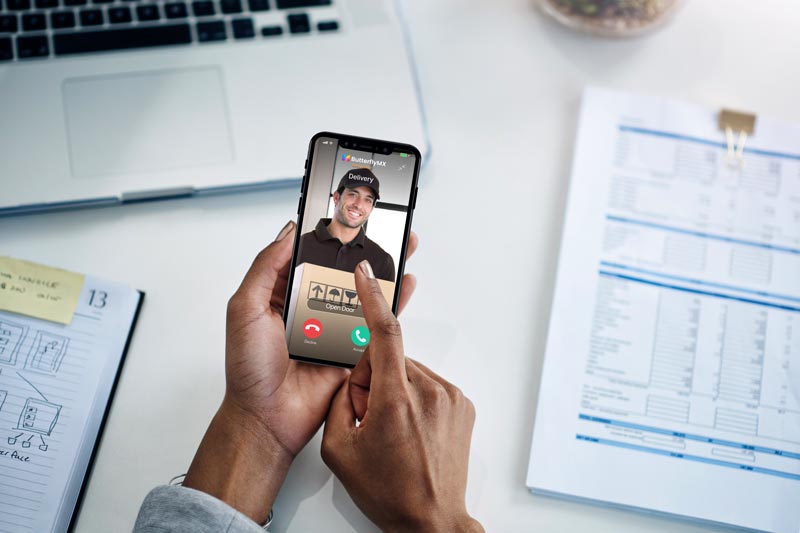
The benefits of a commercial intercom system with a mobile app are endless:
- Tenants and building staff can grant property access even if they aren’t on-site. This is great for letting in service providers, maintenance workers, and delivery people.
- If the intercom has a camera, tenants can video chat with visitors right from their smartphones before granting access.
- Tenants and property staff can review an audit trail of door releases. Tenants also get a log of everyone who has called or messaged them from the intercom.
- If a renter forgets their keys, they can still enter the building using their smartphone.
- Staff no longer have to issue keys, keycards, and fobs, which saves the property time and money. The vast majority of people in the U.S. have a smartphone they can use to gain access to your property.
Pro tip: Check the mobile app’s ratings before choosing a commercial intercom that uses smartphones. If the app gets poor reviews, avoid that intercom system entirely.
4. Cloud-based
Commercial property owners and operators aren’t always on-site. That’s why you should choose a cloud-based video intercom.
A cloud-based system allows building staff to manage access permissions and the intercom directory remotely. That means a property manager won’t have to travel to the building just to update the system, as they can update it from anywhere in the world using an online dashboard.
Connect your commercial intercom to Google Workspace to enable automatic system updates. Employees’ information will be automatically added and removed from the intercom system whenever they come or go, saving building staff and office administrators lots of time and hassle.
A cloud-based commercial intercom also allows building owners and operators to remotely:
- View an audit trail of door release events
- Create and assign delivery PINs
- Manage guest access
5. Integrations with other proptech systems
There’s a good chance you use technology in various ways throughout your building. Whatever proptech you rely on, choose a commercial intercom system that integrates with those systems and products.
Here are some examples of integrations between commercial intercoms and other proptech:
- Connect your commercial intercom to your property management software (PMS) to automatically sync your tenant information with the intercom’s directory.
- Integrate the intercom with your access control system to manage tenants’ access to certain parts of the building.
- Connect the intercom with any smart locks in your building so tenants can open doors from one app
Proptech integrations streamline processes for both tenants and property staff, which improves tenant experience and building efficiency. Plus, choosing a commercial intercom with integrations gives you complete control of the technology in your building.
6. Calls multiple tenants, not a front-desk
Some commercial intercom systems only allow visitors to call a single front desk. Others let visitors call any tenant who works in the building. If you’re purchasing a commercial intercom, choose one that lets visitors call specific tenants.
Multi-tenant commercial intercoms are the better option because tenants can speak directly with visitors and grant or deny them access rather than relying on front desk staff to manage visitor access. That saves time for building staff, too, who can instead focus on more important tasks.
Front desk commercial intercoms are too limited for the modern office building. Only a multi-tenant commercial intercom system can accommodate the countless deliveries and visitors your building certainly receives.
7. Easy and affordable installation
When purchasing a commercial intercom system, remember that you’re not just paying for the hardware, you also have to pay someone to install it.
The cost of installing a commercial intercom depends on the materials needed and the complexity of the installation.
Here are some other factors that affect commercial intercom installation costs:
- How many intercoms you need. If you’re only installing one intercom at one entrance, you’ll spend a lot less than if you’re installing several intercoms at multiple points of entry.
- Where you’re installing the intercom. Installing an intercom right next to the door it controls costs less than installing one on a pedestal 20 feet away from your front gate.
- Intercom wiring. If your commercial intercom system requires running wiring between the base station and substations throughout the building, you could be facing a hefty installation bill. In contrast, a wireless intercom system for business is simpler and cheaper to install.
- In-unit hardware. If your intercom uses in-unit hardware (instead of smartphones), you’ll have to pay someone to install those devices throughout your building — which adds up.
The easier and more affordable the installation, the better. And the cheapest and simplest commercial intercom to install is one without building wiring or in-unit hardware.
8. Contactless and touchless entry
Today, contactless and touchless access are convenient, sought-after forms of entry.
- Contactless entry is when visitors can receive property access remotely. That means a tenant or staff member doesn’t have to physically be in the building or come in contact with the visitor to let them in.
- Touchless entry is when a tenant, staff member, or visitor can enter the building without touching the door or gate.
Contactless entry creates seamless access for tenants and their guests, which substantially improves the tenant experience. Tenants can come and go as they please without relying on a front desk or staff member to let them in. Building staff also benefit — they can open the door for service providers and maintenance workers anywhere, any time.
Watch how ButterflyMX provides touchless entry:
9. Works at gates and parking entrances
Many commercial properties require access control beyond the building’s front door. Maybe your building has a parking garage or is behind a locked gate. If you want to manage access at these entrances, you’ll need a commercial gate intercom.
Choose an intercom system that lets you manage multiple entrances, all from one place. The best commercial intercoms let you manage access from an online dashboard for every entrance.
10. Offers several property access methods
A good commercial intercom will let you open the door for guests remotely. But the best commercial intercom offers more than one way to open the door.
Look for a commercial intercom system that offers many property access methods, such as:
- Visitor Passes: Visitor Passes are QR codes that can be sent in advance to a guest via text or email. One-time and recurring Visitor Passes are great for granting access to interviewees, vendors, and service providers.
- Delivery PINs: For seamless delivery driver access, you can issue delivery PINs to every courier. Delivery PINs can be for one-time or recurring use.
- Mobile app: An intercom with a mobile app allows tenants to open the door from their smartphones using a swipe-to-open feature.
- Voice commands: Choose an intercom that integrates with Siri & Alexa so tenants can open the door with just their voice.
- Apple Watch: Some commercial intercoms with a mobile app allow you to open doors from an Apple Watch.
- Bluetooth: Intercoms with Bluetooth capabilities allow tenants to open the door with a Bluetooth-connected device.
11. Provider has a solid track record
Before purchasing any commercial intercom system, be sure to check out what others have to say about the company and its products. Read reviews from real customers. If you know anyone with that brand’s intercom installed in their building, ask them how they like it.
Your commercial intercom system is an investment you’re making in your building and your tenants’ experience. So make sure you purchase a reliable product from a provider with positive reviews and a strong track record of providing great service.
The last factor to consider is whether the intercom provider offers live support. If you encounter any questions or issues, you’ll want to talk to a company representative in real-time. Your best bet is to choose a company that offers live support in your time zone.
Choosing a more robust commercial intercom system
Selecting the right commercial intercom system is essential for ensuring seamless communication and access control at your property. While there are many options available, ButterflyMX stands out for its combination of reliability, simplicity, and cutting-edge features.
Why choose ButterflyMX?
When you choose ButterflyMX, you’re doing more than investing in an intercom system; you’re elevating your property’s access control experience. Join the thousands of property owners who have simplified property access with ButterflyMX and discover why it’s the go-to solution for commercial buildings.
Here are some of the top reasons to consider choosing ButterflyMX for your commercial intercom system:
- Innovative design and technology
- Durability
- Easy installation
- Seamless integration and management
- Proven performance
Innovative design and technology
ButterflyMX delivers a modern solution with a wide-angle touchscreen Video Intercom designed for a mobile-first world. The sleek and intuitive interface is both user-friendly and visually appealing, offering a bright 8” or 12” LED screen available in surface or recessed mounting options.
Alternatively, the built-in camera on our Video Intercom System boasts a 156° wide-angle field of view for enhanced security and clearer vision of the entryway.
Durability
Designed for durability, ButterflyMX Video Intercoms have a weatherproof rating of IP65, making them ideal for indoor and outdoor installations. Weatherproofing such as this ensures your intercom system can withstand the demands of any environment.
Furthermore, our commercial intercoms are vandal-resistant, affording you and your tenants peace of mind.
Easy installation
Say goodbye to costly wiring and in-unit hardware. ButterflyMX operates using your building’s existing internet connection, eliminating the need for extensive infrastructure upgrades. This not only reduces installation costs but also accelerates deployment.
What’s more, our Video Intercom System’s wireless installation process means that it can be retrofitted into almost any intercom’s previous location when you decide to upgrade.
Seamless integration and management
ButterflyMX integrates effortlessly with popular property management software including Appfolio and Yardi, allowing building staff to manage access and tenants to open doors via their smartphones. What’s more, our online dashboard streamlines system oversight, giving your team more time to focus on delivering exceptional service.
Not to mention, our system is easily scalable, allowing you to seamlessly add new tenants to your directory using the cloud-based portal.
Proven performance
Trusted by over 15,000 buildings and backed by 40,000 five-star reviews, ButterflyMX has redefined property access for commercial spaces. Our user-friendly design has made it a favorite among tenants and property managers alike.
Further highlighting the popularity of our systems, Superintendent Mike Porche at the Mill Neck Manor School for the Deaf says, “Everyone [at the school] felt empowered to request access and communicate with visitors in a way that was comfortable for them.”
Integrating your commercial intercom systems
Integrating ButterflyMX with your existing business security and commercial property management system is one of the smartest ways to unify operations, streamline access control, and elevate the overall tenant and visitor experience. ButterflyMX is designed with APIs, allowing it to seamlessly connect with the tools you’re already using, from access control platforms and property management systems to communication software and building automation tools.
Instead of juggling multiple disjointed platforms, you get a centralized, cohesive security and access ecosystem that works more efficiently and delivers better outcomes for your staff, tenants, and vendors.
For property managers, this means dramatically reducing administrative overhead. Integrations with leading property management systems (PMS) such as Yardi, Entrata, and RealPage allow ButterflyMX to automatically sync resident directories and lease data in real time.
Commercial intercom system FAQs
- What is the difference between a paging system and an intercom system?
- How much does it cost to get an intercom system?
What is the difference between a paging system and an intercom system?
A paging system is typically one-way communication used to broadcast announcements across large areas, while an intercom system allows for two-way communication between specific points, enabling conversations and access control features.
How much does it cost to get an intercom system?
The cost of a commercial intercom system can range from $1,000 to over $10,000, depending on the size of the building, the number of entry points, and whether it’s audio-only or includes video and mobile access features.

Get your free quote!
Fill in the form below, and we'll email you right back.
Want a free quote?
Fill in the form below, and we'll email you right back.
You’ll be redirected shortly...
